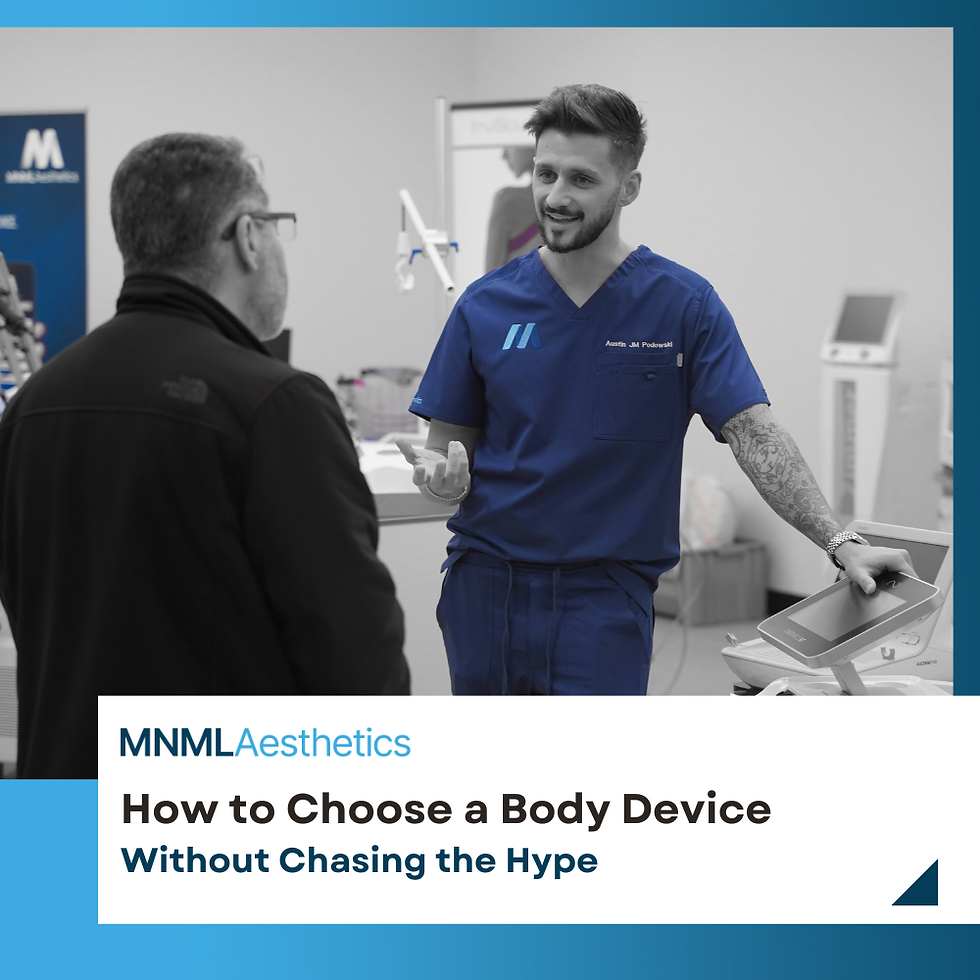How to Choose a Body Device Without Chasing the Hype
- Jack Burrows
- Jul 7
- 3 min read
Updated: Aug 13

The Problem with Flashy Marketing Claims
In a competitive and ever-evolving aesthetics market, it’s easy to be dazzled by bold marketing. Buzzwords like 'revolutionary,' 'non-invasive miracle,' and 'FDA cleared' are often plastered across trade show booths and Instagram ads. But behind many of these claims is a serious lack of clinical substance.Providers must remember that aesthetic devices are capital investments—ones that should be evaluated not for flash, but for performance, reliability, and long-term profitability. Hype can sell a device, but it won’t generate repeat bookings, satisfied clients, or strong clinical outcomes. Smart purchasing starts with cutting through the noise.
Questions to Ask Manufacturers and Reps
When evaluating a new body contouring or muscle-stimulating device, ask pointed, evidence-based questions. Some of the most critical include:- What clinical studies support the efficacy of your technology?- Is the device FDA cleared—and under what product code?- What’s the average treatment duration and how many sessions are needed for results?- What kind of post-sale support, training, and marketing is included?- What consumables or ongoing fees should I expect?- Can you provide 3–5 real clinic references using this system for at least 6 months?The more specific your questions, the less room there is for scripted responses and vague claims.
Key Criteria: Efficacy, Support, Training, Serviceability
The four pillars of any successful aesthetic device purchase are:
Evaluation Criteria | Key Considerations |
Efficacy | Does the device consistently deliver on promised outcomes? Are the mechanisms of action scientifically sound? |
Support | Are customer service and troubleshooting fast and accessible? |
Training | Will your staff receive thorough, hands-on training, or just a PDF manual and video link? |
Serviceability | Can parts be replaced easily? Is on-site service available? What’s the average repair turnaround time? |
These factors determine not only client outcomes but also clinic efficiency and staff confidence.
The Value of Predicate FDA Clearance
Many aesthetic technologies rely on predicate FDA clearance, meaning they’re approved based on similarity to an existing device. While this doesn’t negate effectiveness, it does mean that new branding or features may not come with new clinical scrutiny.For example, a device with a new handpiece shape or LED display might claim to be ‘new,’ but if it uses the same foundational technology as its predecessor, there may be little to no improvement in results.Ask reps to clarify exactly what aspect of the device is cleared and under which classification. Don’t mistake FDA registration or general wellness approval for full clearance related to treatment claims.
Comparing Apples to Apples: Spec Sheet Breakdown
Device performance can often be decoded from the technical spec sheet—if you know what to look for. Key areas to examine:
Technical Feature | Description |
Power output (W/cm², Tesla, mA) | Higher isn’t always better but should align with treatment goals. |
Pulse duration and frequency ranges | Determine comfort and depth of penetration. |
Treatment area size and handpiece flexibility | Impacts how many body zones can be treated simultaneously. |
Software features | Customizability, session presets, and feedback systems matter. |
Create a simple spreadsheet to compare your top contenders side by side. This takes emotion out of the decision-making process and focuses on value.
Tips for Evaluating ROI—Not Just Upfront Cost
A low sticker price doesn’t guarantee profitability. True ROI comes from the ability to:- Deliver consistent results- Scale treatments with minimal staff time- Cross-sell or bundle into other services- Rebook clients for maintenanceConsider the following in your cost analysis:- How many sessions will it take to recoup the investment?- What’s the average client spend per package?- Are consumables or memberships recurring revenue opportunities?The device that seems expensive upfront may be the better long-term investment if it delivers reliable results and higher margins.
Peer-Reviewed vs. Paid Studies: Red Flags
Some device companies present studies that look scientific but are actually marketing pieces in disguise. Be cautious if:- The study is not published in a peer-reviewed journal- The sample size is under 20 participants- The data is self-reported or lacks objective measurement tools- The study is sponsored and authored by the device manufacturerAlways ask for third-party validation or clinical references. Independent studies with imaging, biometrics, or histological proof carry far more weight than whitepapers written by the sales team.
Comments